Antennae
| Antennae | ||||||||||||
|---|---|---|---|---|---|---|---|---|---|---|---|---|

Tiger Spatula ( Pseudoplatystoma tigrinum ) |
||||||||||||
| Systematics | ||||||||||||
|
||||||||||||
| Scientific name | ||||||||||||
| Pimelodidae | ||||||||||||
| Bonaparte , 1838 |
The antenna catfish (Pimelodidae) are native to the rivers of Central and South America , from the extreme south of Mexico to the north of Argentina and on islands of the Caribbean . With over 110 species in over 30 genera , they are a very species-rich catfish family.
features
The family is named after three pairs of long thin barbels , of which the upper jaw barbels are the longest and can protrude beyond the caudal fin. Usually they are stretched forward. The head is large and can be severely flattened. In many species it is only covered by a very thin skin, so that the skull bones are clearly visible. The mouth is terminal. The body is scaly, elongated and often very long. The sideline is usually complete, straight or slightly curved. The smallest species Megalonema pauciradiatum is only 3.8 centimeters tall, while Brachyplatystoma filamentosum reaches a length of 3.6 meters. The dorsal fin sits relatively far forward. In most cases, they and the pectoral fins have a fin spine. The caudal fin is usually deeply forked, sometimes with pointed tips, or rounded. The adipose fin is well developed, often very large, and in a few species it is connected to the caudal fin.
Way of life
Antenna catfish populate large rivers, jungle lakes and streams. They are particularly common in the murky white water rivers of the Amazon basin . They are mostly crepuscular and nocturnal. Most species are solitary, but many also live in small groups. Antennae catfish feed on fish, crustaceans and other invertebrates. Large species can also prey on smaller mammals up to the size of a monkey. Some species also eat fruit. Reproduction is largely unknown. Many species make spawning migrations.
External system
The catfish form the superfamily Pimelodoidea with the big mouth catfish (Pseudopimelodidae), the Heptapteridae and the species Conorhynchos conirostris, which is not assigned to any family .
Internal system
There are around 110 species, which are assigned to around 30 genera.
- Genus Steindachneridion
- Steindachneridion amblyurum ( Eigenmann & Eigenmann , 1888)
- Steindachneridion doceanum ( Eigenmann & Eigenmann , 1889)
- Steindachneridion melanodermatum Garavello , 2005
- Steindachneridion scriptum ( Miranda Ribeiro , 1918)
- Steindachneridion parahybae ( Steindachner , 1877)
- Steindachneridion punctatum ( Miranda Ribeiro , 1918)
-
Phractocephalus Leiarius group
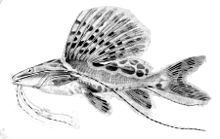 Sail catfish ( Leiarius pictus )
Sail catfish ( Leiarius pictus )- Genus Leiarius
- Leiarius arekaima ( Jardine , 1841)
- Leiarius longibarbis ( Castelnau , 1855)
- Leiarius marmoratus ( Gill , 1870)
-
Sailing catfish ( Leiarius pictus ( Müller & Troschel , 1849) )
 Redtail catfish ( Phractocephalus hemioliopterus )
Redtail catfish ( Phractocephalus hemioliopterus )
- Genus Phractocephalus
- Redtail catfish ( Phractocephalus hemioliopterus Bloch & Schneider , 1801 )
- Genus Leiarius
-
Calophysus group
- Genus Aguarunichthys
- Aguarunichthys inpai Zuanon, Rapp Py-Daniel & Jégu , 1993
- Aguarunichthys tocantinsensis Zuanon, Rapp Py-Daniel & Jégu , 1993
- Aguarunichthys torosus Stewart , 1986
- Genus Calophysus
- Calophysus macropterus ( Lichtenstein , 1819)
- Genus Luciopimelodus
- Luciopimelodus pati ( Valenciennes , 1835)
- Genus Pimelodina
- Pimelodina flavipinnis Steindachner , 1877
- Genus Pinirampus
- Pinirampus pirinampu ( Spix & Agassiz , 1829)
- Genus Aguarunichthys
-
Pimelodus group
- Genus Bagropsis
- Bagropsis reinhardti Lütken , 1874
- Genus Bergiaria
- Bergiaria platana ( Steindachner , 1908)
- Bergiaria westermanni ( Lütken , 1874)
- Genus Cheirocerus
- Cheirocerus abuelo ( Schultz , 1944)
- Cheirocerus eques Eigenmann , 1917
- Cheirocerus goeldii ( Steindachner , 1908)
- Genus Duopalatinus
- Duopalatinus emarginatus ( Valenciennes , 1840)
- Duopalatinus peruanus Eigenmann & Allen , 1942
- Genus Exallodontus
- Exallodontus aguanai Lundberg, Mago-Leccia & Nass , 1991
- Genus Iheringichthys
- Iheringichthys labrosus ( Lütken , 1874)
- Iheringichthys megalops Eigenmann & Ward , 1907
- Genus Parapimelodus
- Parapimelodus nigribarbis ( Boulenger , 1889)
-
Parapimelodus valenciennis ( Lütken , 1874)
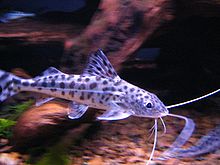 Angel antenna catfish ( Pimelodus pictus )
Angel antenna catfish ( Pimelodus pictus )
- Genus Pimelodus
- Pimelodus absconditus Azpelicueta , 1995
- Pimelodus albicans ( Valenciennes , 1840)
- Pimelodus albofasciatus Mees , 1974
- Pimelodus altissimus Eigenmann & Pearson , 1942
- Pimelodus argenteus Perugia , 1891
- Pimelodus atrobrunneus Vidal & Lucena , 1999
- Pimelodus blochii Valenciennes , 1840
- Pimelodus brevis Marini, Nichols & La Monte , 1933
- Pimelodus britskii Garavello & Shibatta , 2007
- Pimelodus coprophagus Schultz , 1944
- Pimelodus fur ( Lütken , 1874)
- Pimelodus garciabarrigai Dahl , 1961
- Pimelodus grosskopfii Steindachner , 1879
- Pimelodus halisodous Ribeiro, Lucena & Lucinda , 2008
- Pimelodus heraldoi Azpelicueta , 2001
- Pimelodus jivaro Eigenmann & Pearson , 1942
- Pimelodus joannis Ribeiro, Lucena & Lucinda , 2008
- Pimelodus maculatus Lacepède , 1803
- Pimelodus microstoma Steindachner , 1877
- Pimelodus mysteriosus Azpelicueta , 1998
- Pimelodus navarroi Schultz , 1944
- Pimelodus ornatus Kner , 1858
- Pimelodus Ortmanni Haseman , 1911
- Pimelodus pantaneiro Souza-Filho & Shibatta , 2007
- Pimelodus paranaensis Britski & Langeani , 1988
- Pimelodus parvus Boulenger , 1898
- Angel antenna catfish ( Pimelodus pictus Steindachner , 1876 )
- Pimelodus pintado Azpelicueta, Lundberg & Loureiro , 2008
- Pimelodus platicirris Borodin , 1927
- Pimelodus pohli Ribeiro & Lucena , 2006
- Pimelodus punctatus ( Meek & Hildebrand , 1913)
- Pimelodus quadratus Ballen et al. , 2016
- Pimelodus speciosus Costa e Silva et al., 2018
- Pimelodus stewarti Ribeiro, Lucena & Lucinda , 2008
- Pimelodus tetramerus Ribeiro & Lucena , 2006
- Genus Platysilurus
- Platysilurus malarmo Schultz , 1944
- Platysilurus mucosus ( Vaillant , 1880)
- Platysilurus olallae ( Orcés , 1977)
- Genus Platystomatichthys
- Platystomatichthys sturio ( Kner , 1858)
- Genus Propimelodus
- Propimelodus araguayae Rocha, de Oliviera & Rapp Py-Daniel , 2007
- Propimelodus caesius Parisi, Lundberg & Donascimiento , 2006
- Propimelodus eigenmanni ( van der Stigchel , 1946)
- Genus Bagropsis
- Sorubiminae
- Genus Zungaro
- Zungarowels ( Zungaro zungaro ( Humboldt , 1821) )
-
Sorubim group
- Genus Hemisorubim
-
Hemisorubim platyrhynchos ( Valenciennes , 1840)
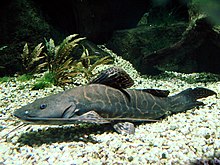 Leopard antenna catfish ( Perrunichthys perruno )
Leopard antenna catfish ( Perrunichthys perruno )
-
Hemisorubim platyrhynchos ( Valenciennes , 1840)
- Genus Perrunichthys
- Leopard antenna catfish ( Perrunichthys perruno Schultz , 1944 )
- Genus Pseudoplatystoma
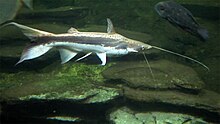 Spatula catfish ( Sorubim lima )
Spatula catfish ( Sorubim lima ) - Genus Sorubim
- Sorubim cuspicaudus Littmann, Burr & Nass , 2000
- Sorubim elongatus Littmann, Burr, Schmidt & Isern , 2001
- Spatula catfish ( Sorubim lima ( Bloch & Schneider , 1801) )
- Sorubim maniradii Littmann, Burr & Buitrago-Suarez , 2001
- Sorubim trigonocephalus Miranda-Ribeiro , 1920
- Genus Sorubimichthys
- Sorubimichthys planiceps ( Spix & Agassiz , 1829)
- Tribe Brachyplatystomatini
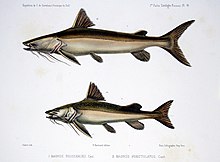 above Brachyplatystoma rousseauxii ; below an indefinite species of Brachyplatystoma
above Brachyplatystoma rousseauxii ; below an indefinite species of Brachyplatystoma- Genus Brachyplatystoma
- Subgenus Brachyplatystoma :
- Brachyplatystoma juruense ( Boulenger , 1898)
- Brachyplatystoma platynemum Boulenger , 1898
- Brachyplatystoma tigrinum ( Britski , 1981)
- Brachyplatystoma vaillantii ( Valenciennes , 1840)
- Subgenus Malacobagrus
- Brachyplatystoma capapretum Lundberg & Akama , 2005
- Brachyplatystoma filamentosum ( Lichtenstein , 1819)
- Brachyplatystoma rousseauxii ( Castelnau , 1855)
- Subgenus Brachyplatystoma :
- Genus Platynematichthys
- Platynematichthys notatus ( Jardine & Schomburgk in Schomburgk , 1841)
- Genus Brachyplatystoma
- Genus Hemisorubim
- Genus Zungaro
-
incertae sedis
- Genus Hypophthalmus
- Hypophthalmus edentatus Spix & Agassiz , 1829
- Hypophthalmus fimbriatus Kner , 1857
- Hypophthalmus marginatus Valenciennes , 1840
- Hypophthalmus oremaculatus Nani & Fuster , 1947
- Genus Megalonema
- Megalonema amaxanthum Lundberg & Dahdul , 2008
- Megalonema argentinum ( MacDonagh , 1938)
- Megalonema orixanthum Lundberg & Dahdul , 2008
- Megalonema pauciradiatum Eigenmann , 1919
- Megalonema platanum ( Günther , 1880)
- Megalonema platycephalum Eigenmann , 1912
- Megalonema psammium Schultz , 1944
- Megalonema xanthum Eigenmann , 1912
- Genus Zungaropsis
- Zungaropsis multimaculatus Steindachner , 1908
- Genus Hypophthalmus
literature
- Joseph S. Nelson : Fishes of the World. 4th edition. John Wiley & Sons, Hoboken NJ 2006, ISBN 0-471-25031-7 .
- Peter Bucher: zoo animal husbandry 5. Fish . German Harri GmbH, 2005, ISBN 3-8171-1352-8
- Günther Sterba : Freshwater fish in the world . Weltbild Verlag, Augsburg 2004, ISBN 3-89350-991-7 .
Individual evidence
- ↑ Megalonema pauciradiatum on Fishbase.org (English)
- ↑ Brachyplatystoma filamentosum on Fishbase.org (English)
- ↑ JP Sullivan, Lundberg JG; Hardman M: A phylogenetic analysis of the major groups of catfishes (Teleostei: Siluriformes) using rag1 and rag2 nuclear gene sequences . In: Mol Phylogenet Evol. . 41, No. 3, 2006, pp. 636-62. doi : 10.1016 / j.ympev.2006.05.044 .
- ↑ Lundberg, John G., Akama, Alberto (2005): Brachyplatystoma capapretum: a New Species of Goliath Catfish from the Amazon Basin, with a Reclassification of Allied Catfishes (Siluriformes: Pimelodidae). Copeia 2005 (3): 492-516. doi : 10.1643 / CI-04-036R1
- ↑ Stewart, Donald J. (1986): Revision of Pimelodina and Description of a New Genus and Species from the Peruvian Amazon (Pisces: Pimelodidae) . Copeia 1986 (3): 653-672. doi : 10.2307 / 1444947
- ^ Fishbase list of species
- ^ FishBase
Web links
- Antennenwelse on Fishbase.org (English)



